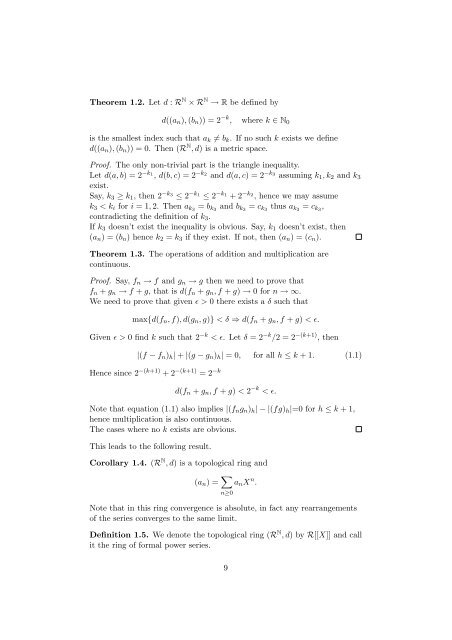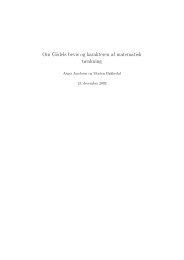Master Dissertation
Master Dissertation
Master Dissertation
You also want an ePaper? Increase the reach of your titles
YUMPU automatically turns print PDFs into web optimized ePapers that Google loves.
Theorem 1.2. Let d : R N × R N → R be defined by<br />
d((an), (bn)) = 2 −k , where k ∈ N0<br />
is the smallest index such that ak = bk. If no such k exists we define<br />
d((an), (bn)) = 0. Then (R N , d) is a metric space.<br />
Proof. The only non-trivial part is the triangle inequality.<br />
Let d(a, b) = 2−k1 −k2 , d(b, c) = 2<br />
exist.<br />
−k3 and d(a, c) = 2 assuming k1, k2 and k3<br />
Say, k3 ≥ k1, then 2−k3 −k1 −k1 −k2 ≤ 2 ≤ 2 + 2 , hence we may assume<br />
= bk3 and bk3 = ck3 thus ak3 = ck3 ,<br />
k3 < ki for i = 1, 2. Then ak3<br />
contradicting the definition of k3.<br />
If k3 doesn’t exist the inequality is obvious. Say, k1 doesn’t exist, then<br />
(an) = (bn) hence k2 = k3 if they exist. If not, then (an) = (cn).<br />
Theorem 1.3. The operations of addition and multiplication are<br />
continuous.<br />
Proof. Say, fn → f and gn → g then we need to prove that<br />
fn + gn → f + g, that is d(fn + gn, f + g) → 0 for n → ∞.<br />
We need to prove that given ɛ > 0 there exists a δ such that<br />
max{d(fn, f), d(gn, g)} < δ ⇒ d(fn + gn, f + g) < ɛ.<br />
Given ɛ > 0 find k such that 2 −k < ɛ. Let δ = 2 −k /2 = 2 −(k+1) , then<br />
|(f − fn)h| + |(g − gn)h| = 0, for all h ≤ k + 1. (1.1)<br />
Hence since 2 −(k+1) + 2 −(k+1) = 2 −k<br />
d(fn + gn, f + g) < 2 −k < ɛ.<br />
Note that equation (1.1) also implies |(fngn)h| − |(fg)h|=0 for h ≤ k + 1,<br />
hence multiplication is also continuous.<br />
The cases where no k exists are obvious.<br />
This leads to the following result.<br />
Corollary 1.4. (RN , d) is a topological ring and<br />
(an) = <br />
anX n .<br />
n≥0<br />
Note that in this ring convergence is absolute, in fact any rearrangements<br />
of the series converges to the same limit.<br />
Definition 1.5. We denote the topological ring (R N , d) by R[[X]] and call<br />
it the ring of formal power series.<br />
9



